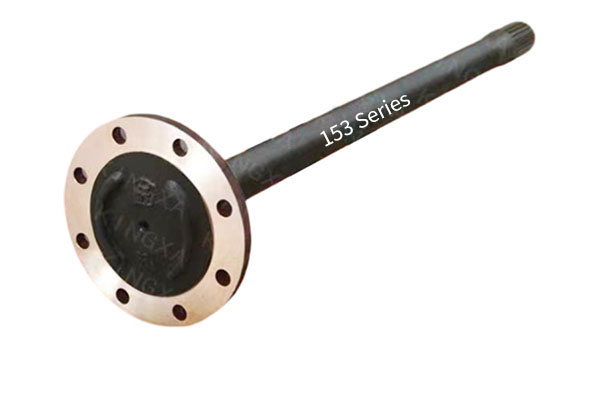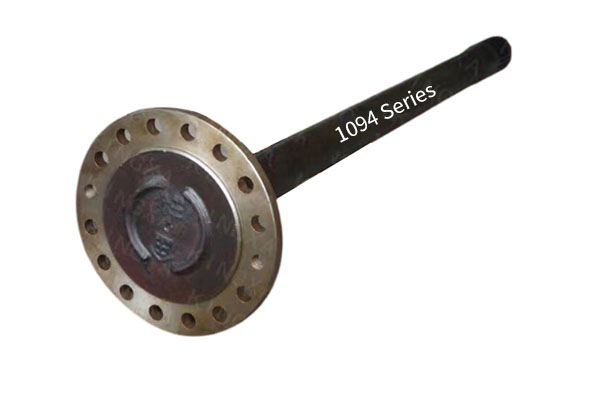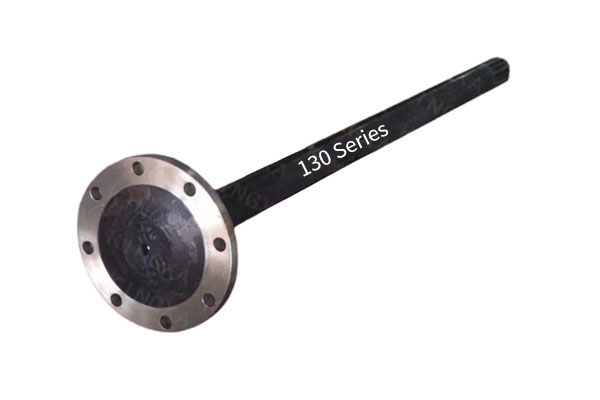What is the performance stability of the Heavy-Duty Vehicle Rear Axle Half Shaft under heavy-load conditions?
Release Time : 2024-11-13
Under heavy-load conditions, the performance stability of the Heavy-Duty Vehicle Rear Axle Half Shaft is one of the key factors to ensure the safe and reliable operation of the vehicle.
1. Requirements for the rear axle half shaft under heavy-load conditions
Under heavy-load conditions, the Heavy-Duty Vehicle Rear Axle Half Shaft needs to withstand huge torque and load, while also coping with complex and changing driving environments. Therefore, it must have high strength, high toughness, good wear resistance and corrosion resistance to ensure stable performance under various extreme conditions.
2. Performance stability analysis of the rear axle half shaft
Material selection:
High-quality raw materials are the basis for manufacturing high-performance half shafts. Under heavy-load conditions, materials such as high-strength alloy steel or cast iron are usually used, which have good mechanical properties and wear resistance.
The strength and toughness of the half shaft can be further improved by optimizing the chemical composition and metallographic structure of the material.
Heat treatment technology:
Heat treatment is one of the key technologies to improve the performance stability of the rear axle. Through heat treatment processes such as quenching and tempering, the hardness and strength of the axle can be significantly improved while maintaining good toughness and impact resistance.
Quenching is the process of heating the axle to above the critical temperature and then cooling it rapidly. This process can significantly improve the hardness of the axle, but it also requires strict control of temperature and time to avoid deformation or cracking of the axle.
Tempering is a heat treatment step after quenching, which aims to eliminate the internal stress generated by quenching and improve the toughness and fatigue resistance of the axle.
Support type:
For heavy-duty trucks, the full-floating axle support type is widely used due to its unique advantages. This type can effectively reduce the force and torque borne by the axle and improve the stability and reliability of the vehicle.
The main feature of the full-floating axle support type is that the axle is not directly connected to the axle housing, but is supported in the seat hole of the reducer housing through the differential housing. This structure allows the axle to withstand torque while being unaffected by other forces and torques transmitted by the axle housing.
Surface treatment technology:
In addition to heat treatment, surface treatment technologies such as spraying, electroplating and nitriding can also be used to further improve the performance of the half shaft. These technologies can improve the wear resistance and corrosion resistance of the half shaft, making it better adaptable to complex and changing driving environments.
3. Performance evaluation and quality control
Performance evaluation:
After the heat treatment is completed, the performance of the half shaft needs to be evaluated. Common evaluation methods include hardness testing, impact testing and metallographic analysis. Through these tests, the performance of the half shaft can be fully understood, providing a basis for subsequent improvements.
Quality control:
In order to ensure the stability and reliability of the quality of the half shaft after heat treatment, a series of quality control measures need to be taken. This includes strictly implementing the heat treatment process specifications, strengthening process monitoring and recording, and conducting regular quality spot checks.
The causes of the problems found should be analyzed in a timely manner and measures should be taken to solve them to prevent the problems from expanding and affecting product quality.
In summary, under heavy-load conditions, the performance stability of the Heavy-Duty Vehicle Rear Axle Half Shaft is the key to ensuring its safe and reliable operation. The performance stability of the half shaft can be significantly improved by optimizing material selection, applying heat treatment technology, selecting appropriate support types, and adopting surface treatment technology. At the same time, it is also necessary to strengthen performance evaluation and quality control to ensure that the quality of the half shaft meets relevant standards and requirements.
1. Requirements for the rear axle half shaft under heavy-load conditions
Under heavy-load conditions, the Heavy-Duty Vehicle Rear Axle Half Shaft needs to withstand huge torque and load, while also coping with complex and changing driving environments. Therefore, it must have high strength, high toughness, good wear resistance and corrosion resistance to ensure stable performance under various extreme conditions.
2. Performance stability analysis of the rear axle half shaft
Material selection:
High-quality raw materials are the basis for manufacturing high-performance half shafts. Under heavy-load conditions, materials such as high-strength alloy steel or cast iron are usually used, which have good mechanical properties and wear resistance.
The strength and toughness of the half shaft can be further improved by optimizing the chemical composition and metallographic structure of the material.
Heat treatment technology:
Heat treatment is one of the key technologies to improve the performance stability of the rear axle. Through heat treatment processes such as quenching and tempering, the hardness and strength of the axle can be significantly improved while maintaining good toughness and impact resistance.
Quenching is the process of heating the axle to above the critical temperature and then cooling it rapidly. This process can significantly improve the hardness of the axle, but it also requires strict control of temperature and time to avoid deformation or cracking of the axle.
Tempering is a heat treatment step after quenching, which aims to eliminate the internal stress generated by quenching and improve the toughness and fatigue resistance of the axle.
Support type:
For heavy-duty trucks, the full-floating axle support type is widely used due to its unique advantages. This type can effectively reduce the force and torque borne by the axle and improve the stability and reliability of the vehicle.
The main feature of the full-floating axle support type is that the axle is not directly connected to the axle housing, but is supported in the seat hole of the reducer housing through the differential housing. This structure allows the axle to withstand torque while being unaffected by other forces and torques transmitted by the axle housing.
Surface treatment technology:
In addition to heat treatment, surface treatment technologies such as spraying, electroplating and nitriding can also be used to further improve the performance of the half shaft. These technologies can improve the wear resistance and corrosion resistance of the half shaft, making it better adaptable to complex and changing driving environments.
3. Performance evaluation and quality control
Performance evaluation:
After the heat treatment is completed, the performance of the half shaft needs to be evaluated. Common evaluation methods include hardness testing, impact testing and metallographic analysis. Through these tests, the performance of the half shaft can be fully understood, providing a basis for subsequent improvements.
Quality control:
In order to ensure the stability and reliability of the quality of the half shaft after heat treatment, a series of quality control measures need to be taken. This includes strictly implementing the heat treatment process specifications, strengthening process monitoring and recording, and conducting regular quality spot checks.
The causes of the problems found should be analyzed in a timely manner and measures should be taken to solve them to prevent the problems from expanding and affecting product quality.
In summary, under heavy-load conditions, the performance stability of the Heavy-Duty Vehicle Rear Axle Half Shaft is the key to ensuring its safe and reliable operation. The performance stability of the half shaft can be significantly improved by optimizing material selection, applying heat treatment technology, selecting appropriate support types, and adopting surface treatment technology. At the same time, it is also necessary to strengthen performance evaluation and quality control to ensure that the quality of the half shaft meets relevant standards and requirements.







